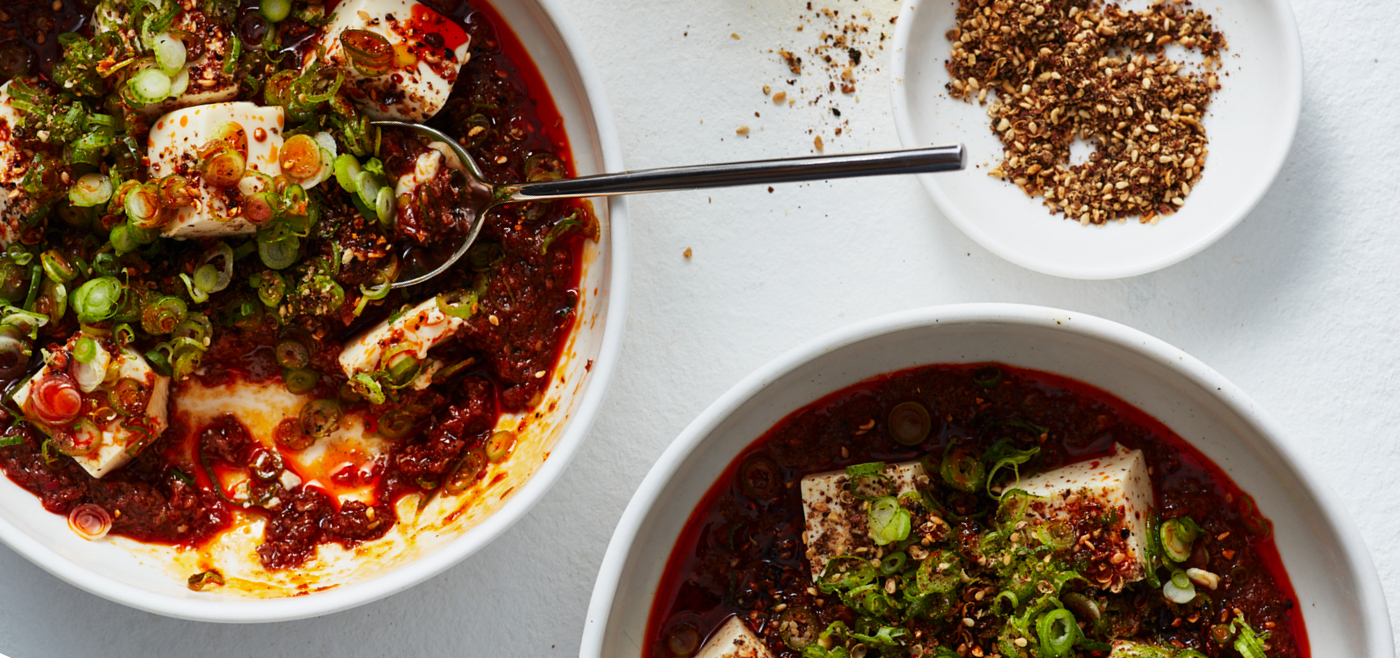How to Make Josh Niland's Tuna Mapo Tofu
30 Aug 2021 | Hardie Grant Books

But just how easy is it to take Josh’s recipes home to cook in your own kitchen?
To find out, our Head of Marketing, Shalini Kunahlan, dove into Josh’s world of delicious fish cookery with Take One Fish’s modified version of an all-time favourite, Mapo Tofu.
Read Shalini’s cooking journey below with tips that she picked up along the way, and don’t miss the recipe excerpt so you too can give it a try!
Shalini's Lockdown Tuna Mapo Tofu
Working for a cook book publisher certainly has its privileges: Josh Niland’s hot new fish cookbook Take One Fish beckoned with spectacular delights, but it was his Tuna Mapo Tofu recipe that resonated with my Melbourne lockdown bubble. It was the perfect project cook recipe. A project cook, by our definition, had to have the right amount of difficulty; fun to construct and execute and will make you feel you’ve just jumped 10 levels on Gods. Yep, I’m 37.
Throughout the litany of Victorian lockdowns, I had joined the online streaming bandwagon with my music fanatic husband. We played records to a small bunch of friends which became an important creative activity that keep our happiness chemicals in check, the dopamine sort. But when lockdown #5 hit, the turn tables disappeared into the clutches of a repair shop, showing no signs of return. When I panic bought a pasta machine, I realised that cooking advanced recipes was going to be the thing that replaced playing records. This is why lockdown project cooking has been popularised worldwide. Instead of being on your third glass of wine by 6pm, you get to nourish your soul and mind.
Mapo Tofu is the iconic fiery dish from Sichuan province. Most Chinese restaurants feature it on their menu because it belongs on best comfort food listicles everywhere (there are great vegetarian versions with mushrooms). Try and prove this hyperbole wrong when creamy silken tofu pours down your throat and moreish chunks of pork mince tightly packed with flavour– salty, spicy and sour all at once–bite back at you. The soul of this dish is Doubanjiang – be sure to practice saying DBJ with the right Mandarin intonation. A powerful spicy, fermented broad bean paste not for the faint hearted. Alas, all this wonderful-ness, betrays the somewhat disparaging translation of Mapo Tofu: pock-marked grandmother tofu.
Josh Niland, being the king of fish cookery, substitutes the traditional pork in Mapo Tofu for yellow-fin tuna belly. A not-so-oft used part of the Tuna fish. As Josh points out, “From a culinary perspective, tuna holds a great deal of potential that goes well beyond the 50–77 per cent yield that tends to be realised”.
Our Brunswick, Melbourne bubble had a great time making Josh’s iteration of Mapo Tofu. It was fun, challenging and we nailed his ethos of cooking extraordinary food by using all parts of the fish. Read on to find out how it turned out.
Full recipe listed below requisite waffle.
- The recipe calls for 1.8kg of yellow fin tuna belly, for 10-12 serves. I was a little flabbergasted, never having bought such a large quantity of fish and flatly refused the job of mincing the beautiful piece of fish. Matt (husband) is much better at that anyway. Remember to bring it home and take it out of the plastic immediately, if you haven’t managed to convince your fishmonger to place fish directly into a sealed container, negating the use and waste of plastic (thank you Josh Niland "Request the fish be wrapped in paper, not plastic. Fish that is stored in plastic at variable temperatures will start perspiring, become damp and develop ammonia aromas (aka ‘fishy fish’)").
Matt’s turn to get flabbergasted: we had a serious quibble about the amount of ginger and garlic (190g of each) required for the dish. Possibly because he was tired from mincing all that fish. I put my food totalitarian hat on and insisted we uphold the balance of flavours. Imagine what half the amount of garlic and ginger would have done with 375g of notorious DBJ!
- Blitzing the ginger, shallots, DBJ, and oil to a smooth paste. Smelt incredible.
- Patiently fry off the paste for 15 min and you’ll get an aroma so layered and sophisticated it will torment your neighbours.
- Fry the tuna in batches. The tuna turns into an amazing robust meat-like texture.
- Add tuna to the cooked paste, stir through the tofu and heat for 3 minutes. Top with spring onion, sesame seeds, chilli and a must: ground Sichuan peppercorns.
- When Matt was painstakingly dicing tuna, bits of sinew appeared. Instead of throwing it out he fried it in butter and seasoned it with salt. It was mind blowing and tasted like pork crackling. Mr. Niland would be proud.
- We paired the fiery Mapo Tofu with a cooling tomato and white onion salad dressed with lemon juice and salt. It was the perfect accompaniment. Something I would not have thought of because I’ve never seen a tomato salad on a Chinese menu, ever. But the lateral thinker in Matt made it happen.
Your Turn! Find the Full Recipe Below to Try at Home
|
INGREDIENTS SERVES 6 1 tablespoon sichuan peppercorns 190 g (6½ oz) fresh ginger, peeled 190 g (6½ oz) garlic cloves, peeled 10 French shallots, peeled 375 g (13 oz) doubanjiang (fermented broad bean paste) 300 ml (10 fl oz) grapeseed oil 80 ml (2 ½ fl oz/1/3 cup) Shaoxing rice wine 50 g (13/4 oz) caster (superfine) sugar 125 ml (4 fl oz/ ½ cup) tamari 1 tablespoon sesame oil 1.8 kg (4 lb) minced (ground) yellowfin tuna 200 g (7 oz) silken tofu, cut into small cubes 1 bunch spring onions (scallions), finely sliced 40 g (1 ½ oz/ ¼ cup) toasted sesame seeds 1 dried red chilli, finely sliced (optional) steamed short-grain rice, to serve |
METHOD Toast the sichuan peppercorns in a dry frying pan until fragrant, then use a mortar and pestle to grind to a rough powder. Set aside. Place the ginger, garlic, shallots, doubanjiang and 150 ml (5 fl oz) of the grapeseed oil in a food processor and blitz to a smooth paste. Heat 100 ml (3 ½ fl oz) of the remaining grapeseed oil in a large heavy-based saucepan over a high heat. Add the paste and fry, stirring occasionally, for 8–10 minutes until dried and fragrant, then reduce the heat and simmer for a further 15 minutes, until the rawness from the vegetables has been completely cooked out. Stir in the shaoxing wine, sugar, tamari and one-third of the ground sichuan peppercorns, then spoon the mixture into a large bowl. Wipe out the pan, add the sesame oil and remaining 2 ½ tablespoons of grapeseed oil and heat over a high heat. Working in two batches, add the tuna mince to the pan and fry for 2 minutes, or until the mince is coloured and has separated into individual strands, then stir through the fried paste mixture to combine. To assemble the mapo tofu, return the tuna mixture to the saucepan and warm through over a low heat. Add the tofu, cover with a lid and heat for 3 minutes, then spoon into serving bowls. Top with the spring onion, sesame seeds, chilli, if using, and the remaining ground sichuan peppercorns. Serve with steamed rice, if you like. |







